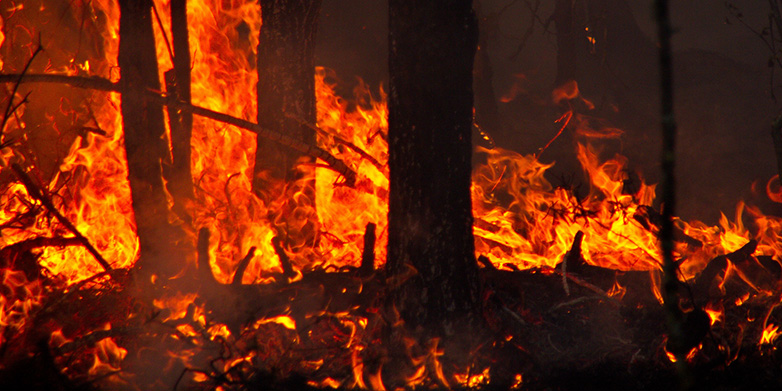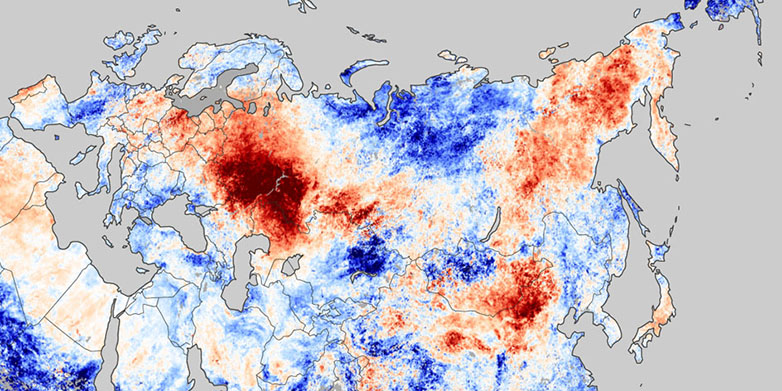Concurrent hot and dry summers more common in future
In the past, climate scientists have tended to underestimate the risk of a co-occurrence of heatwave and drought. This is the conclusion of one of the first studies to examine compound climate extremes.

A combination of severe drought and a heatwave caused problems for Russia in the summer of 2010: fires tore through forests and peat bogs. Moscow was shrouded in thick smog, causing many deaths in the local population. At the same time, Pakistan was engulfed in heavy rain, as the high-pressure area over Russia blocked a low-pressure zone over Pakistan. This led to the country’s worst flooding for centuries.
According to the statistics, however, such extreme climate events, similar to the heatwave that affected large areas of western and central Europe in the summer of 2003, are only supposed to occur around every 100 years. But as global warming pushes average temperatures higher, the frequency of several extreme weather events is set to increase, experts claim.
Concurrent extremes more frequent
Perhaps the statisticians need to check their figures. Researchers have traditionally studied extreme climate events such as heatwaves and drought in isolation, producing separate forecasts of how frequently each one is likely to occur. But when these extremes coincide – a combination of hot and dry summers, for example – their impact is far greater.
ETH researcher Jakob Zscheischler and Professor Sonia Seneviratne from the ETH Institute for Atmospheric and Climate Science have now calculated the probability of compound climate extremes, as the co-occurrence of severe heat and drought generally depends on the correlation between temperature and precipitation in the summer. The results of their study have just been published in the academic journal "Science Advances”.
Co-occurrence as much as five times greater than expected
In their study, Zscheischler and Seneviratne have calculated that the combination of heat and drought is as much as two to four times more frequent than if these two extreme climate events are studied in isolation. In America’s mid-west, for instance, the probability of this combination occurring is even up to five times higher.

Calculating the probability of these two extremes separately and then combining them is not the same as establishing the likelihood of their co-occurrence. “Our calculations clearly show that compound climate extremes occur much more frequently than previously expected,” says the ETH professor.
Zscheischler and Seneviratne have analysed the combination of heatwaves and drought because observations show that “there are definite correlations between such compound climate events,” she goes on to explain. This was the reason for the extremely hot and dry summer that central Europe experienced in 2015. “These scenarios are becoming more common.”
Correlation amplified by unconstrained climate change
In their study, the authors show that the correlation between temperature and precipitation will intensify if climate change remains unconstrained. As a result, very hot and dry summers will become increasingly common.
The greater frequency of compound climate extremes also poses a bigger threat to agriculture, society and the economy. If two climate extremes are examined together, the probability of their co-occurrence often rises dramatically due to previously unaccounted dependences – along with the associated risks. The latest calculations show that the risk is far greater than previously assumed, the ETH professor warns: “We’re not properly prepared for this.”
In terms of health risks, an intense heatwave can lead to dehydration and even premature death in the elderly and very young population. In agriculture, severe drought can ruin crops or lead to escalating irrigation costs. Forest fires are also more frequent in case of co-occurrent droughts and heatwaves, such as for the recent conflagrations in Portugal.
Chain reaction in a connected world
“If climate extremes are only studied in isolation, we risk underestimating the potential threat,” stresses Professor Seneviratne. “In today’s highly connected world it is more important than ever to assess these risks accurately.”
2010 was a classic example of how extreme climate events no longer affect just one country, but can also – given the interconnectivity of the modern world – spill over to regions with more stable weather patterns. When wheat yields fell as a result of severe drought, Russia halted exports to Egypt to ensure it could still meet domestic demand for wheat. This ramped up wheat prices in Egypt, badly affecting certain parts of the population and creating political instability.
Professor Seneviratne says that climate scientists have traditionally underestimated the effect of compound climate events and have not yet researched them in an appropriate way. This new study is one of the first to address this shortcoming, and help prepare us for what might be in store. “Adjustments will be necessary at all levels,” she notes.
Reference
Zscheischler J, Seneviratne S. Dependence of drivers affects risks associated with compound events. Science Advances, 2017; 3:e1700263, 30 June 2017. DOI: external page10.1126/sciadv.1700263call_made
